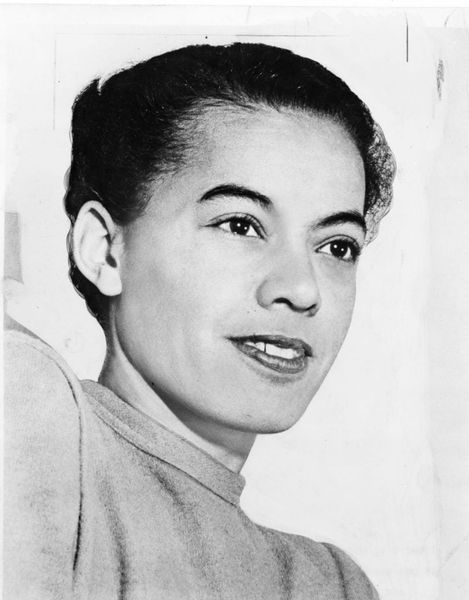GM – FBF – Today’s American Champion was an American civil rights activist who became a lawyer, a women’s rights activist, Episcopal priest, and author. Drawn to the ministry in 1977, she was the first African-American woman to be ordained as an Episcopal priest, in the first year that any women were ordained by that church. Born in Baltimore, Maryland, she was virtually orphaned when young, and she was raised mostly by her maternal grandparents in Durham, North Carolina. At the age of 16, she moved to New York City to attend Hunter College, and graduated with a Bachelor of Arts degree in English in 1933. In 1940, she sat in the whites-only section of a Virginia bus with a friend, and they were arrested for violating state segregation laws. This incident, and her subsequent involvement with the socialist Workers’ Defense League, led her to pursue her career goal of working as a civil rights lawyer. She enrolled in the law school at Howard University, where she also became aware of sexism. She called it “Jane Crow”, alluding to the Jim Crow laws that enforced racial segregation in the Southern United States. She graduated first in her class, but she was denied the chance to do post-graduate work at Harvard University because of her gender. She earned a master’s degree in law at University of California, Berkeley, and in 1965 she became the first African American to receive a Doctor of Juridical Science degree from Yale Law School.As a lawyer, she argued for civil rights and women’s rights. National Association for the Advancement of Colored People (NAACP) Chief Counsel Thurgood Marshall called her 1950 in his book, States’ Laws on Race and Color, the “bible” of the civil rights movement. She served on the 1961–1963 Presidential Commission on the Status of Women, being appointed by John F. Kennedy. In 1966 she was a co-founder of the National Organization for Women. Ruth Bader Ginsburg named her as a coauthor of a brief on the 1971 case Reed v. Reed, in recognition of her pioneering work on gender discrimination. This case articulated the “failure of the courts to recognize sex discrimination for what it is and its common features with other types of arbitrary discrimination.” She held faculty or administrative positions at the Ghana School of Law, Benedict College, and Brandeis University.In 1973, she left academia for activities associated with the Episcopal Church. She became an ordained priest in 1977, among the first generation of women priests. She struggled in her adult life with issues related to her sexual and gender identity, describing herself as having an “inverted sex instinct”. She had a brief, annulled marriage to a man and several deep relationships with women. In her younger years, she occasionally had passed as a teenage boy. A number of scholars, including a 2017 biographer, have retroactively classified her as transgender. In addition to her legal and advocacy work, she published two well-reviewed autobiographies and a volume of poetry. Her volume of poetry, Dark Testament, was republished in 2018.Today in our History – July 1, 1985 – Anna Pauline “Pauli” Murray (November 20, 1910 – July 1, 1985) died.Pauli Murray was born Anna Pauline Murray in Baltimore, Maryland. After her parents’ death, she spent her childhood in North Carolina and New York. After graduating from Hunter College in 1928, she shortened her name to Pauli to embrace a more androgynous identity. During the Great Depression, Murray worked for the Works Progress Administration and the Workers Defense League and taught for the New York City Remedial Reading project.Murray was arrested in 1940 for disorderly conduct on an interstate bus trip where she challenged the constitutionality of segregating bus passengers. This incident, coupled with her time working with the Workers Defense League, inspired her to attend law school at Howard University. While there, she participated in civil rights protests in an attempt to desegregate public facilities. She also joined with George Houser, James Farmer, and Bayard Rustin to form the Congress of Racial Equality (CORE). Murray graduated from Howard with honors and planned on completing a post-graduate fellowship at Harvard University. She was denied admission at Harvard because of her gender. She ultimately finished her post-graduate work at UC Berkeley School of Law. Soon after, she published States’ Laws on Race and Color, regarded as the “bible” of civil rights work. She went onto receive her J.S.D. from Yale University, the first African American to receive this degree.After several appointments at universities around the country, Murray decided to devote her life to her Christian beliefs. In 1977, Murray became the first African American woman to be ordained as an Episcopal priest. She worked in a parish in Washington, D.C., based in ministry to the sick until her retirement in 1982. Murray died of pancreatic cancer in Pittsburgh, Pennsylvania, on July 1, 1985.Researchers have discovered that Murray struggled with her sexuality and gender identity during her lifetime. Rosalind Rosenberg, author of Jane Crow: The Life of Pauli Murray, asserts that Murray identified as a transgendered man but did not have the information or acceptance available during her lifetime to describe it. Research more about this great American Champion and share it with your babies. Make it a champion day!

